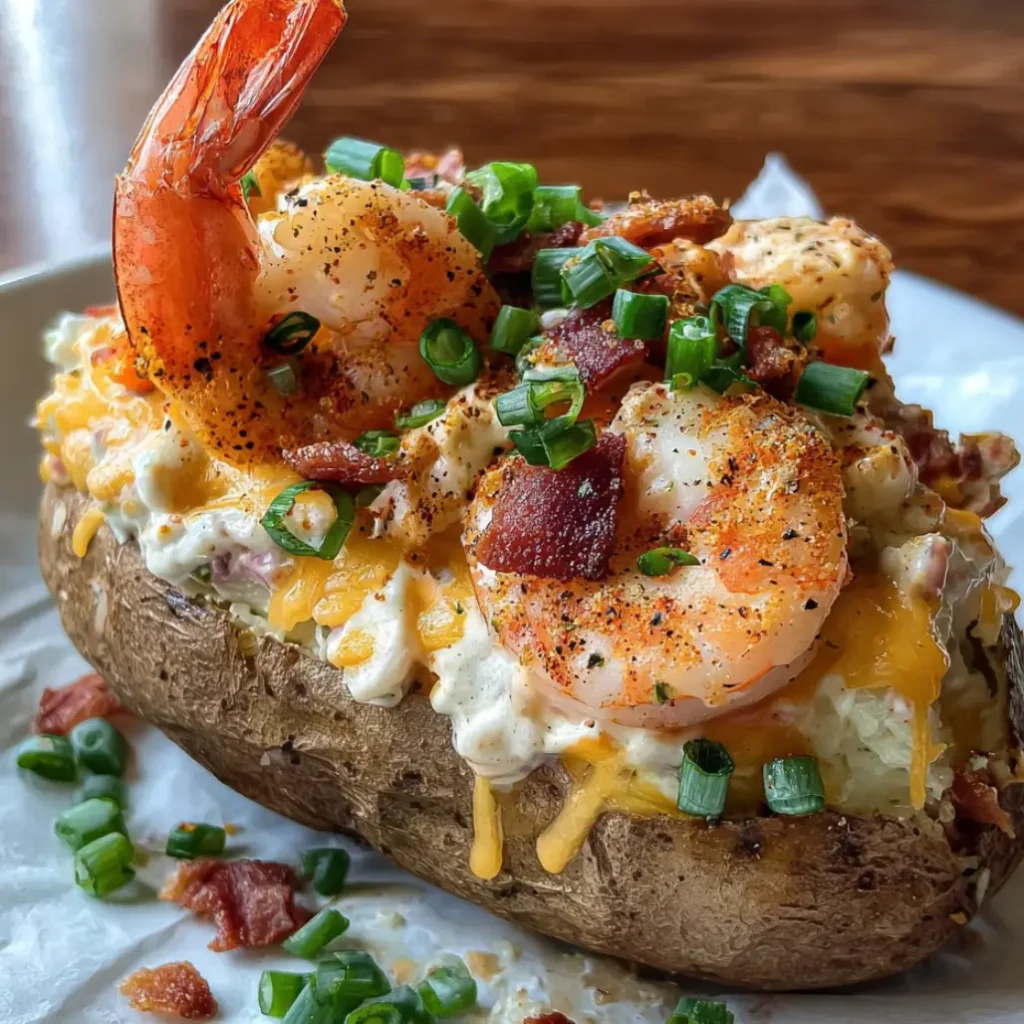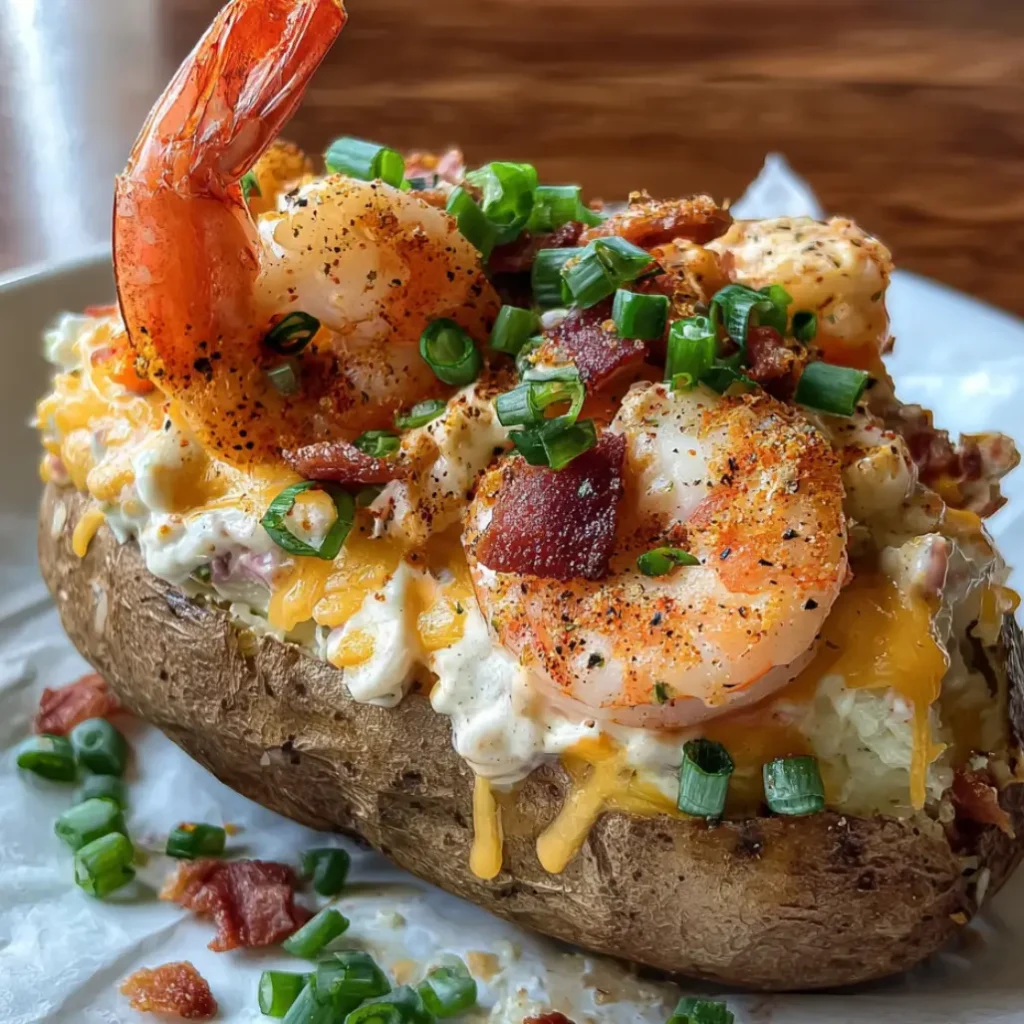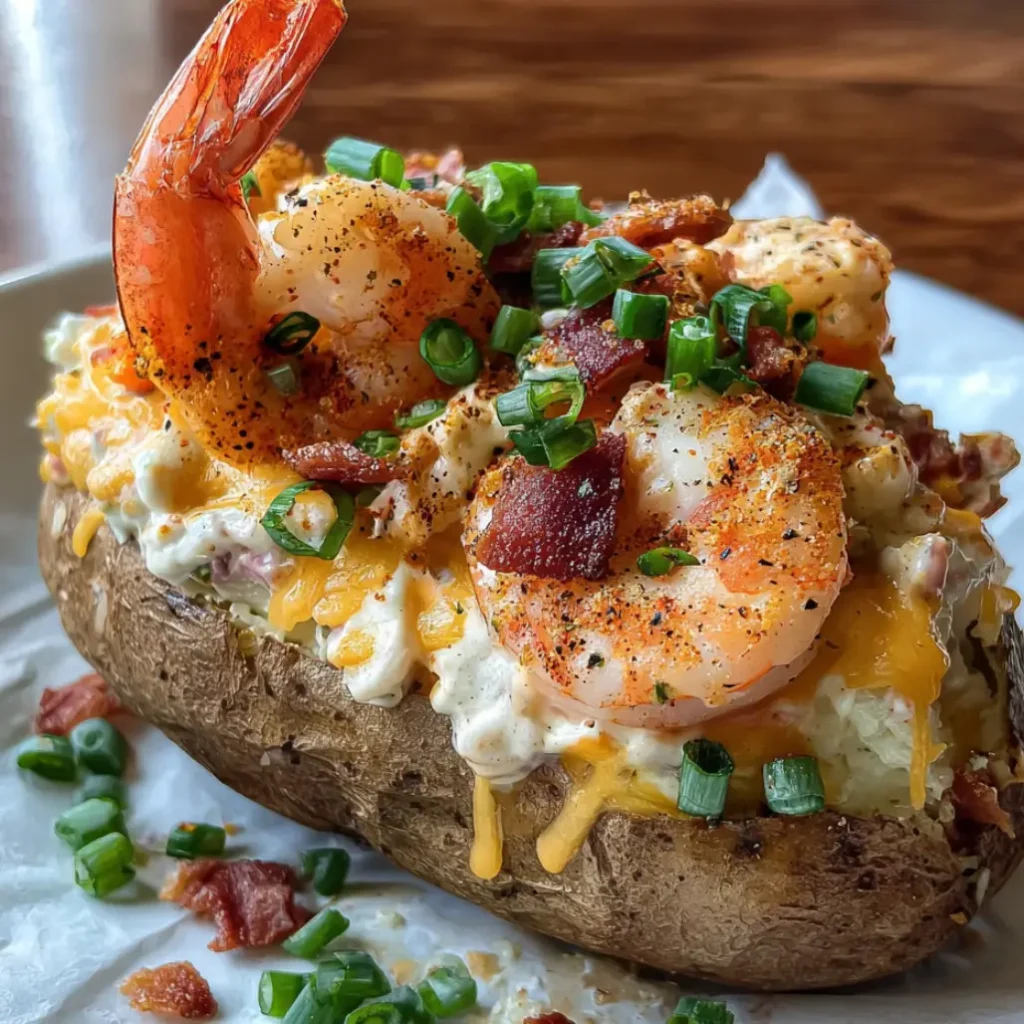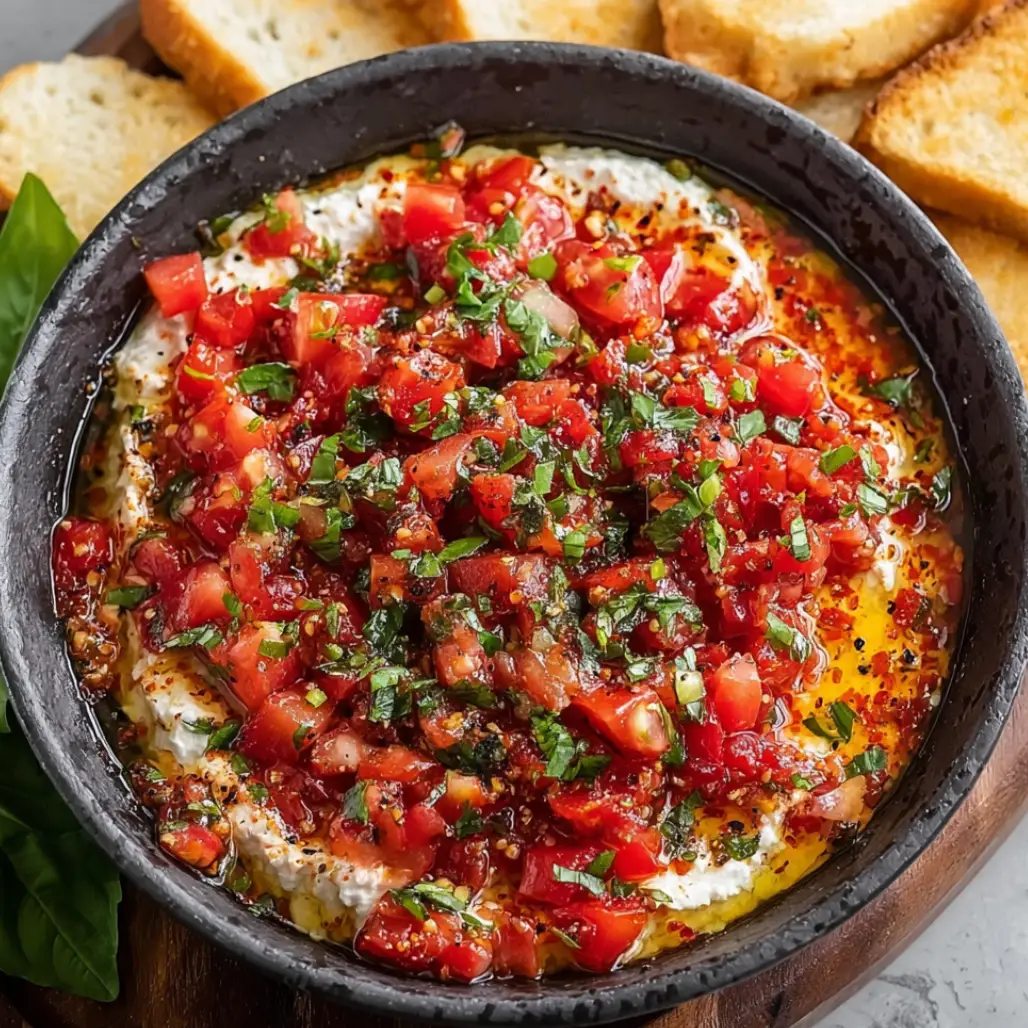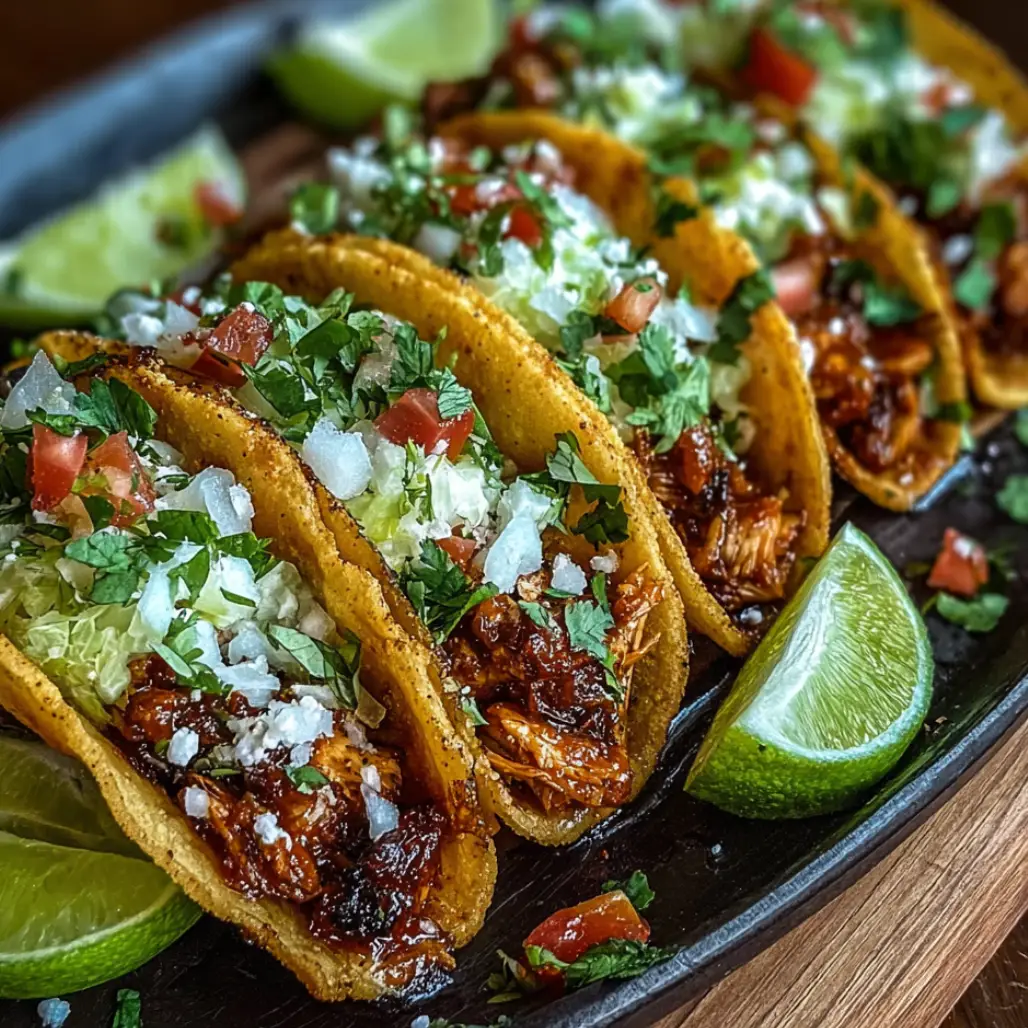| Prep Time: | 20 minutes |
|---|---|
| Cook Time: | 75 minutes |
| Total Time: | 95 minutes |
| Serves: | 4 |
There’s something undeniably magical about transforming the humble baked potato into a luxurious seafood feast that elevates comfort food to restaurant-quality dining because when you combine perfectly fluffy russet potatoes with succulent shrimp, tender crab meat, and a rich, creamy cheese sauce, you create a dish that speaks to both the soul and the palate. This seafood loaded baked potato represents the perfect marriage of land and sea, where crispy potato skins cradle clouds of buttery potato flesh topped with an abundance of fresh seafood and melted cheese because every bite delivers layers of flavor and texture that make ordinary dinners feel like special occasions.
Why This Seafood Loaded Baked Potato Will Transform Your Dinner Table
The beauty of this seafood loaded baked potato lies in its ability to take two beloved comfort foods and merge them into something extraordinary because while traditional loaded potatoes satisfy with bacon and cheese, this version elevates the entire experience with premium seafood that adds elegance without sacrificing the cozy, satisfying nature that makes baked potatoes so appealing. The contrast between the crispy, seasoned potato skin and the creamy, seafood-laden interior creates textural excitement in every forkful because the natural sweetness of shrimp and crab meat harmonizes beautifully with the earthy richness of perfectly baked potatoes.
What sets this recipe apart from ordinary stuffed potatoes is the careful balance of flavors and the attention to technique because each component is prepared to showcase its best qualities, from the properly seasoned and baked potato foundation to the perfectly cooked seafood that remains tender and flavorful. The cheese sauce brings everything together with its velvety richness that coats each piece of seafood and potato because when you master this dish, you’ll have a showstopper meal that works equally well for intimate family dinners or impressive entertaining.
The versatility of this seafood loaded baked potato makes it a valuable addition to any cook’s repertoire because you can adapt the seafood selection based on availability and preference, whether you choose premium lump crab meat, succulent shrimp, or a combination of your favorite coastal treasures. This recipe also teaches fundamental techniques for baking perfect potatoes and creating creamy sauces that will serve you well in countless other dishes because once you understand these building blocks, you can create variations that suit any season or occasion.
Essential Ingredients for Perfect Seafood Loaded Baked Potatoes
For the Potatoes:
- 4 large russet potatoes (8-10 ounces each, for optimal fluffiness)
- 2 tablespoons olive oil (for crispy, golden skin)
- 2 teaspoons coarse sea salt (essential for proper seasoning)
- 1 teaspoon garlic powder (adds savory depth)
For the Seafood Mixture:
- 1 pound large shrimp (peeled and deveined, 21-25 count)
- 8 ounces lump crab meat (picked over for shells)
- 2 tablespoons Old Bay seasoning (classic seafood spice blend)
- 1 teaspoon paprika (for color and mild heat)
- 1/2 teaspoon cayenne pepper (adjust to taste)
- 3 tablespoons butter (for sautéing seafood)
For the Creamy Filling:
- 4 ounces cream cheese (softened for smooth mixing)
- 1/2 cup sour cream (adds tangy richness)
- 1/4 cup heavy cream (for ultimate creaminess)
- 2 cups sharp cheddar cheese (shredded, divided)
- 1/4 cup chives (fresh, finely chopped)
- 2 cloves garlic (minced for aromatic depth)
For the Finishing Touches:
- 1/4 cup green onions (sliced thin for fresh garnish)
- 2 tablespoons fresh parsley (chopped for color and flavor)
- Lemon wedges (for serving and brightness)
- Hot sauce (optional, for those who love heat)
The Art of Creating the Perfect Seafood Loaded Baked Potato
Creating exceptional seafood loaded baked potatoes requires understanding the interplay between timing, temperature, and technique because each element must be prepared with precision to achieve the perfect balance of flavors and textures that make this dish truly memorable. The foundation begins with selecting the right potatoes because russet varieties offer the ideal starch content that creates fluffy, light interiors while developing beautifully crispy skins when properly prepared.
The secret to restaurant-quality results lies in the preparation details because properly cleaning and seasoning the potatoes before baking ensures even cooking and maximum flavor development throughout the entire cooking process. Temperature control becomes crucial when preparing the seafood because overcooking shrimp and crab meat results in tough, rubbery textures that compromise the luxurious nature of this dish, while undercooking poses food safety concerns that no home cook wants to face.
Timing coordination separates novice cooks from experienced ones because this seafood loaded baked potato requires orchestrating multiple components that must come together at precisely the right moment for optimal results. The cheese sauce demands attention to prevent breaking or curdling because cream-based sauces require gentle heat and constant monitoring to maintain their silky, smooth consistency that coats every piece of seafood and potato perfectly.
Understanding ingredient interactions helps create better results because the acidity in sour cream balances the richness of cheese and cream while enhancing the natural sweetness of the seafood. The herbs and spices work synergistically to complement rather than mask the delicate flavors of shrimp and crab because the goal is enhancement, not overpowering these premium ingredients that make this dish special.
Step-by-Step Instructions for Seafood Loaded Baked Potato Mastery
Step 1: Prepare the Foundation Potatoes
Begin by preheating your oven to 425°F because this higher temperature creates the perfect environment for developing crispy skins while ensuring thorough cooking of the potato flesh. Scrub each russet potato under cold running water with a vegetable brush to remove any dirt or debris because clean skins are essential for food safety and optimal texture development.
Pat the potatoes completely dry with paper towels because any remaining moisture will prevent proper browning and crisping during the baking process. Use a fork to pierce each potato 8-10 times around the circumference because these holes allow steam to escape and prevent the potatoes from bursting in the oven.
Rub each potato with olive oil, ensuring complete coverage because this fat helps conduct heat evenly while promoting the golden, crispy skin that provides textural contrast to the fluffy interior. Season generously with coarse sea salt and garlic powder because proper seasoning at this stage penetrates the skin and enhances the overall flavor profile of the finished dish.
Professional Tip: Choose potatoes of similar size to ensure even cooking times and wrap each individually in aluminum foil for more even heat distribution.
Key Points: Proper potato preparation is fundamental to success because well-prepared potatoes create the perfect foundation for all the delicious toppings that follow.
Step 2: Bake to Perfection
Place the prepared potatoes directly on the middle oven rack because this positioning allows hot air to circulate around the entire potato for even cooking and optimal skin development. Bake for 60-75 minutes, depending on size, because larger potatoes require additional time to achieve the proper internal temperature and texture.
Test for doneness by gently squeezing the potato with an oven mitt because properly cooked potatoes yield slightly to pressure while maintaining their shape. The internal temperature should reach 210°F for perfectly fluffy flesh because this temperature ensures complete starch conversion for the lightest, most appealing texture.
Professional Tip: Immediately pierce each potato with a knife after removing from the oven to release steam and prevent the flesh from becoming dense or gummy.
Key Points: Proper baking technique creates the ideal foundation because perfectly cooked potatoes provide the best texture and flavor base for the seafood toppings.
Step 3: Prepare the Seafood Components
While the potatoes bake, prepare your seafood because timing coordination ensures everything comes together at the optimal moment for serving. Pat the shrimp completely dry with paper towels because excess moisture prevents proper browning and can make the seafood mixture watery.
Season the shrimp with Old Bay seasoning, paprika, and a pinch of cayenne because these spices complement the natural sweetness of seafood while adding depth and complexity to the overall flavor profile. Heat 2 tablespoons of butter in a large skillet over medium-high heat because this moderate temperature allows proper cooking without burning the delicate seafood.
Sauté the shrimp for 2-3 minutes per side until they turn pink and opaque because overcooking results in tough, rubbery texture that compromises the luxurious nature of this dish. Remove the cooked shrimp to a plate and gently fold in the lump crab meat because crab is already cooked and only needs warming through.
Professional Tip: Reserve any pan juices from cooking the seafood because these flavorful drippings can be incorporated into the cheese sauce for enhanced taste.
Key Points: Proper seafood preparation maintains tender textures and bright flavors because gentle cooking preserves the premium quality that makes this dish special.
Step 4: Create the Creamy Cheese Filling
Cut each baked potato lengthwise and carefully scoop out the flesh, leaving about 1/4 inch of potato attached to the skin because this creates sturdy shells that hold the filling while maintaining structural integrity. Place the hot potato flesh in a large mixing bowl because working with warm potatoes makes mashing easier and creates smoother textures.
Add the softened cream cheese, sour cream, and heavy cream to the potato flesh because these dairy components create the rich, luxurious base that makes this dish so indulgent. Mash everything together until smooth and creamy because proper mixing eliminates lumps and creates the perfect consistency for stuffing back into the potato shells.
Fold in 1 1/2 cups of shredded cheddar cheese, minced garlic, and chopped chives because these ingredients add flavor complexity and visual appeal to the creamy potato mixture. Season with salt and pepper to taste because proper seasoning enhances all the other flavors without overpowering the delicate seafood components.
Professional Tip: Use an electric mixer for ultra-smooth potato filling, but be careful not to overmix because this can develop the gluten and create gummy textures.
Key Points: Creating the perfect creamy base requires attention to temperature and mixing technique because smooth, well-seasoned filling provides the ideal backdrop for the seafood.
Step 5: Assembly and Final Baking
Carefully spoon the creamy potato mixture back into the reserved potato shells, mounding it slightly because this creates an attractive presentation while providing ample surface area for the seafood topping. Distribute the cooked seafood mixture evenly over each stuffed potato because proper distribution ensures every bite contains the perfect balance of potato and seafood.
Top each potato with the remaining cheddar cheese because this final layer of cheese melts during the second baking to create a golden, bubbly surface. Return the assembled potatoes to the 425°F oven for 15-20 minutes because this second baking heats everything through while melting the cheese and creating attractive browning.
Watch carefully during the final minutes because the cheese should be melted and lightly golden without becoming burnt or dried out. Remove from the oven when the tops are beautifully golden and the filling is heated through because proper timing ensures optimal texture and appearance.
Professional Tip: Place the stuffed potatoes on a baking sheet lined with parchment paper to catch any drips and make cleanup easier.
Key Points: Proper assembly and final baking create the perfect balance of hot, melted cheese and warm seafood filling because careful attention to detail ensures restaurant-quality results.
Professional Tips for Seafood Loaded Baked Potato Excellence
Temperature management stands as the most critical factor in achieving perfect results because seafood requires precise cooking to maintain its tender texture while the cheese components need gentle heat to prevent breaking or curdling. Use a meat thermometer to ensure shrimp reaches 145°F because this temperature guarantees food safety while preventing overcooking that leads to tough, chewy textures.
Quality ingredient selection makes a dramatic difference in the final result because fresh, high-grade seafood elevates this dish from ordinary to extraordinary, while premium cheeses melt more smoothly and provide superior flavor development. Always purchase shrimp with shells on when possible because shell-on shrimp typically maintains better texture and flavor compared to pre-peeled varieties that may have been sitting longer.
Mise en place becomes essential when preparing this multi-component dish because having all ingredients prepped and ready prevents timing issues that can result in overcooked seafood or cold potatoes. Prepare your cheese sauce base ingredients in advance because cream-based sauces require immediate attention once cooking begins to prevent curdling or breaking.
Consider texture contrasts throughout the dish because the combination of crispy potato skin, creamy filling, tender seafood, and melted cheese creates the sensory experience that makes this dish memorable. Balance flavors carefully because the goal is harmony between the earthy potato base, rich dairy components, and delicate seafood without any single element overpowering the others.
Creative Variations to Customize Your Seafood Loaded Baked Potato
Regional seafood variations allow you to showcase local specialties because substituting lobster meat, scallops, or even flaky white fish creates entirely different flavor profiles while maintaining the fundamental appeal of this comfort food classic. Louisiana-style variations incorporate crawfish tails and Cajun spicing because these ingredients bring heat and regional authenticity that transforms the dish into a New Orleans-inspired creation.
Mediterranean influences work beautifully by substituting feta cheese and incorporating sun-dried tomatoes with fresh herbs like oregano and basil because these flavors complement seafood while creating a completely different cultural experience. Asian fusion approaches using ingredients like sesame oil, ginger, and scallions create exciting flavor combinations because these aromatic elements enhance rather than compete with delicate seafood flavors.
Lightened versions can reduce calories without sacrificing flavor by substituting Greek yogurt for some of the cream cheese and using reduced-fat cheese options because these modifications maintain creaminess while making the dish more health-conscious. Vegetarian adaptations replace seafood with roasted vegetables or mushrooms because these ingredients provide umami depth and satisfying textures for those who don’t consume seafood.
Spice level adjustments accommodate different heat preferences because adding more cayenne, hot sauce, or fresh jalapeños creates excitement for those who enjoy bold flavors, while omitting spicy elements makes the dish accessible to sensitive palates. These variations demonstrate the versatility of the basic technique because once you master the fundamentals, endless creative possibilities emerge.
Perfect Pairing Ideas for Your Seafood Loaded Baked Potato
Fresh salad combinations provide necessary contrast to the rich, creamy potato because crisp greens dressed with light vinaigrette cleanse the palate between bites of indulgent seafood and cheese. Consider exploring various salad options because fresh, acidic components balance the richness while adding nutritional value to the meal.
Wine pairings enhance the dining experience because crisp white wines like Sauvignon Blanc or Pinot Grigio complement seafood without overwhelming delicate flavors, while their acidity cuts through the rich cheese and cream components. Light appetizers served beforehand set the stage for this substantial main course because carefully chosen snacks and appetizers prepare the palate without competing with the star dish.
Side dish considerations should complement rather than compete because simple steamed vegetables or perfectly prepared sides provide color and nutrition without overwhelming the main attraction. Bread options like crusty French bread or dinner rolls help soak up any delicious sauce because these accompaniments extend the enjoyment of every flavorful drop.
Beverage selections beyond wine include light beers, sparkling water with lemon, or refreshing beverages because these drinks cleanse the palate and enhance the overall dining experience. The goal is creating a harmonious meal where every component supports and enhances the others rather than competing for attention.
Discover More Delicious Recipes to Complete Your Menu
Expanding your culinary repertoire with complementary dishes ensures you can create complete, satisfying meals that showcase your cooking skills because variety keeps dining exciting and allows you to explore different flavor profiles and cooking techniques. Consider exploring savory side dishes because these accompaniments provide the perfect foundation for building memorable meals around your seafood loaded baked potato masterpiece.
Sauce and marinade exploration opens new possibilities because flavored dips and marinades can transform simple ingredients into exciting flavor experiences that complement your main dishes. Understanding sauce-making fundamentals helps you create custom accompaniments that perfectly match your personal taste preferences and dietary requirements.
Morning meal planning benefits from considering how breakfast favorites can incorporate similar techniques and ingredients because leftover seafood and cheese components can transform ordinary breakfast dishes into elegant brunch offerings. This approach maximizes ingredient usage while expanding your cooking horizons beyond traditional meal boundaries.
Dessert planning completes the dining experience because well-chosen dessert recipes provide the perfect finale to rich, savory meals like seafood loaded baked potatoes. Light, refreshing desserts work particularly well after indulgent main courses because they cleanse the palate and provide satisfying closure to the meal.
Storage Guidelines for Seafood Loaded Baked Potato Leftovers
Proper storage techniques preserve both safety and quality because seafood requires careful handling to prevent spoilage while maintaining the appealing textures that make this dish special. Refrigerate leftover seafood loaded baked potatoes within two hours of serving because the combination of dairy and seafood creates an environment where bacteria can multiply rapidly at room temperature.
Store components separately when possible because the potato shells maintain better texture when stored apart from the creamy filling and seafood mixture. Place filling and seafood in airtight containers because exposure to air causes flavors to deteriorate and increases the risk of contamination from other refrigerator odors.
Consumption timeline becomes critical with seafood dishes because cooked seafood maintains optimal quality for only 2-3 days when properly refrigerated, while the dairy components may last slightly longer but should be consumed within the same timeframe for best results. Label containers with preparation dates because this simple step prevents confusion and ensures food safety.
Reheating requires gentle techniques because high heat can overcook the seafood and cause the dairy components to break or curdle. Use low oven temperatures around 325°F and cover with foil to prevent drying because gradual reheating preserves textures and flavors better than rapid heating methods like microwaving.
The Science Behind Perfect Seafood Loaded Baked Potato Preparation
Understanding starch conversion explains why proper potato baking technique matters because russet potatoes contain high levels of starch that must be fully converted through heat to achieve the fluffy, light texture that makes baked potatoes so appealing. The 210°F internal temperature represents the point where starch granules fully gelatinize because this process creates the characteristic texture that distinguishes properly baked potatoes from underdone ones.
Protein coagulation in seafood occurs rapidly because the delicate proteins in shrimp and crab meat begin setting at relatively low temperatures, which explains why careful timing prevents overcooking. Understanding this process helps cooks recognize the visual cues that indicate perfectly cooked seafood because properly prepared shrimp turns from translucent to opaque while maintaining tender texture.
Emulsification science governs cream sauce success because the combination of fats and liquids requires proper technique to create stable, smooth mixtures that don’t break or curdle. Temperature control becomes crucial because excessive heat causes proteins to coagulate too rapidly, resulting in lumpy, separated sauces that compromise the dish’s luxurious appeal.
Maillard reaction development occurs on potato skins during baking because the combination of proteins and sugars creates complex flavors and appealing brown colors when exposed to dry heat. This scientific process explains why properly oiled and seasoned potato skins develop such superior flavor and texture compared to simply steamed or boiled potatoes.
Troubleshooting Common Seafood Loaded Baked Potato Issues
Soggy potato skins result from insufficient initial baking or inadequate drainage after stuffing because moisture trapped against the skin prevents the crispy texture that provides important contrast to the creamy filling. Solution involves ensuring potatoes are fully baked before stuffing and draining any excess moisture from the filling mixture before assembly.
Overcooked seafood appears as tough, rubbery pieces that detract from the dish’s luxury appeal because excessive heat or prolonged cooking times cause protein structures to tighten beyond the point of palatability. Prevention requires careful timing and immediate removal from heat once seafood reaches proper doneness indicators like color change and firm texture.
Broken or curdled cheese sauce manifests as lumpy, separated mixtures that fail to provide the smooth, creamy coating that makes this dish special because rapid temperature changes or excessive heat cause dairy proteins to coagulate improperly. Recovery involves removing from heat immediately and whisking in small amounts of cold cream to re-establish the emulsion.
Bland flavor profiles occur when seasoning levels are insufficient or ingredients lack quality because seafood’s delicate nature requires proper seasoning to enhance rather than mask natural flavors. Solution involves tasting throughout the cooking process and adjusting seasoning levels while using high-quality ingredients that provide the best flavor foundation.
Additional Inspiration for Your Seafood Cooking Journey
Expanding your seafood cooking repertoire builds confidence and skills because mastering different techniques and flavor combinations creates a foundation for culinary creativity that extends far beyond this single dish. Consider exploring various cooking methods like grilling, steaming, and poaching because each technique brings out different aspects of seafood’s natural characteristics.
Seasonal adaptation keeps your cooking fresh and exciting because different times of year offer varying seafood selections that can transform familiar recipes into new experiences. Summer preparations might emphasize lighter, brighter flavors while winter versions can incorporate richer, more warming elements that suit colder weather preferences.
Regional exploration introduces authentic techniques and flavor combinations because different coastal cultures have developed unique approaches to seafood preparation that can inspire creative adaptations of familiar dishes. Learning from traditional preparations helps develop understanding of how different ingredients work together harmoniously.
Technique building through practice and experimentation creates the foundation for culinary confidence because mastering fundamental skills like proper sautéing, sauce-making, and timing coordination enables creative freedom in the kitchen. These skills transfer to countless other recipes and cooking situations, making every cooking session more enjoyable and successful.
Conclusion
This seafood loaded baked potato represents the perfect intersection of comfort and elegance because it transforms humble ingredients into something truly special through careful technique and attention to quality. The combination of perfectly baked potatoes, expertly prepared seafood, and rich, creamy accompaniments creates a dish that satisfies both casual weeknight dinners and special occasion entertaining because every element works together to deliver maximum flavor and appeal.
Mastering this recipe provides valuable skills that extend far beyond this single dish because the techniques for baking perfect potatoes, preparing delicate seafood, and creating smooth cheese sauces form the foundation for countless other culinary adventures. The confidence gained from successfully executing this multi-component recipe empowers home cooks to tackle increasingly complex dishes because understanding these fundamental principles opens doors to endless creative possibilities.
The versatility inherent in this seafood loaded baked potato recipe ensures it will remain relevant in your cooking repertoire because the basic framework accommodates seasonal variations, dietary modifications, and personal preference adjustments without losing its essential appeal. Whether you choose to follow the recipe exactly or use it as inspiration for your own creative interpretations, the fundamental principles of quality ingredients, proper technique, and careful timing will always produce satisfying results that bring joy to your table.

